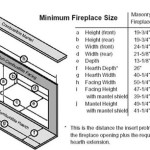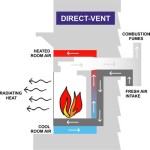Gas Fireplace Alternatives: Exploring Heating and Aesthetic Options
Gas fireplaces are a popular amenity in many homes, offering a blend of supplemental heat and aesthetic appeal. However, they are not without their drawbacks. Concerns about energy efficiency, indoor air quality, and safety, coupled with fluctuating natural gas prices, are prompting homeowners to explore alternative heating and decorative options. This article examines several viable gas fireplace alternatives, highlighting their advantages, disadvantages, and suitability for different needs and preferences.
The decision to replace or forgo a gas fireplace requires careful consideration of several factors. Heating requirements, aesthetic preferences, budget constraints, and environmental consciousness all play a role in selecting the most appropriate alternative. Moreover, local building codes and regulations should be consulted before undertaking any significant changes to a home's heating system.
Electric Fireplaces: Convenience and Versatility
Electric fireplaces represent a readily available and increasingly sophisticated alternative to gas fireplaces. These appliances use electricity to generate heat, often employing a fan to circulate warm air into the room. A primary advantage of electric fireplaces lies in their ease of installation. Requiring only a standard electrical outlet, they can be placed in virtually any room without the need for venting or gas line connections.
Electric fireplaces are available in a wide range of styles, from traditional mantel designs to modern wall-mounted units. Many models feature realistic flame effects, achieved through LED lighting and projection technology, creating a visual appeal comparable to that of a traditional fireplace. Some models even incorporate features such as adjustable flame brightness, color customization, and crackling sound effects, further enhancing the ambiance.
In terms of heating efficiency, electric fireplaces generally provide supplemental heat for smaller spaces. While they may not be sufficient for heating an entire home, they can effectively warm a living room, bedroom, or office. Furthermore, electric fireplaces offer the advantage of zone heating, allowing homeowners to heat only the rooms they are using, potentially reducing overall energy consumption.
However, electric fireplaces are not without their limitations. Their heating capacity is typically lower than that of gas fireplaces, making them less suitable for larger rooms or as a primary heating source. While modern electric fireplaces offer realistic flame effects, they do not replicate the warmth and authenticity of a real fire. Additionally, operating an electric fireplace increases electricity consumption, which can lead to higher energy bills.
The cost of an electric fireplace varies depending on the size, style, and features. Basic models can be relatively inexpensive, while more elaborate units with advanced flame effects and heating capabilities can cost considerably more. Installation costs are typically minimal, as most electric fireplaces can be easily installed by the homeowner.
Wood-Burning Stoves: Traditional Warmth and Aesthetic
Wood-burning stoves offer a classic alternative to gas fireplaces, providing both warmth and a rustic aesthetic. These appliances burn wood as fuel, generating heat through combustion. They are typically constructed of cast iron or steel and are designed to radiate heat efficiently into the surrounding room.
A significant advantage of wood-burning stoves is their ability to provide substantial heat, making them suitable for heating larger spaces or even an entire home. Wood is a renewable resource, and if sourced sustainably, it can be a relatively eco-friendly heating option. The crackling sound and aroma of a wood fire create a cozy and inviting atmosphere that many find appealing.
However, wood-burning stoves also present several challenges. They require a chimney for venting smoke and exhaust gases, which can add to the installation cost. Regular maintenance is necessary, including cleaning the chimney to prevent creosote buildup, a flammable substance that can cause chimney fires. Wood storage is another consideration, as a sufficient supply of dry, seasoned wood must be readily available.
Furthermore, wood-burning stoves can contribute to air pollution, both indoors and outdoors. Burning wood releases particulate matter and other pollutants into the atmosphere, which can have negative health effects. Many municipalities have regulations regarding wood-burning stoves, including restrictions on their use during periods of high air pollution.
The cost of a wood-burning stove varies depending on the size, style, and efficiency. Installation costs can be significant, particularly if a chimney needs to be constructed or modified. The cost of wood also needs to be factored in, which can fluctuate depending on local availability and demand.
Ethanol Fireplaces: Vent-Free Decorative Option
Ethanol fireplaces offer a vent-free alternative to gas fireplaces, providing a decorative flame without the need for a chimney or gas line. These appliances burn bio-ethanol fuel, a renewable alcohol derived from plant sources. Ethanol fireplaces are available in a variety of styles, from freestanding units to wall-mounted models, allowing for flexible placement within a home.
A key advantage of ethanol fireplaces is their ease of installation. Requiring no venting or fuel connections, they can be placed in virtually any room. They produce a real flame, offering a visual appeal similar to that of a traditional fireplace. Ethanol fireplaces are also relatively clean-burning, producing minimal soot or ash.
However, ethanol fireplaces are primarily decorative and provide limited heating capacity. They are best suited for creating ambiance rather than serving as a primary heating source. While they do produce some heat, it is typically not sufficient to warm a large room effectively.
Another consideration is the cost of ethanol fuel. While bio-ethanol is a renewable resource, it can be more expensive than natural gas or wood. The fuel consumption rate of an ethanol fireplace varies depending on the size of the flame and the burner design. It is important to factor in the ongoing cost of fuel when considering this alternative.
Safety is also a paramount concern with ethanol fireplaces. Bio-ethanol is a flammable liquid, and precautions must be taken to prevent spills or leaks. It is essential to use only approved bio-ethanol fuel and to follow the manufacturer's instructions carefully. Children and pets should be kept away from operating ethanol fireplaces.
The cost of an ethanol fireplace varies depending on the size, style, and features. Basic models can be relatively inexpensive, while more elaborate units can cost considerably more. The ongoing cost of bio-ethanol fuel should also be considered when evaluating the overall cost-effectiveness of this alternative.
Pellet Stoves: Efficient and Automated Heating
Pellet stoves offer an efficient and often automated alternative to traditional wood-burning stoves. These appliances burn wood pellets, compressed biomass fuel made from recycled wood waste. Pellet stoves feature a hopper that stores the pellets, which are automatically fed into the combustion chamber by an auger.
A primary advantage of pellet stoves is their high heating efficiency. They typically convert a larger percentage of the fuel's energy into heat compared to wood-burning stoves. Pellet stoves also produce less smoke and particulate matter, making them a cleaner-burning option. The automated fuel feeding system allows for consistent and controlled heat output.
Pellet stoves require electricity to operate the auger and other components. A venting system is also necessary to exhaust flue gases. While the venting requirements are typically less stringent than those for wood-burning stoves, proper installation is crucial for safety and efficiency.
Wood pellets need to be purchased and stored, which requires adequate space. The cost of pellets can fluctuate depending on local availability and demand. Regular maintenance is necessary, including cleaning the burn pot and venting system.
Pellet stoves offer a balance of efficiency, automation, and environmental friendliness. They can be a suitable alternative to gas fireplaces for homeowners seeking a reliable and sustainable heating option.
The cost of a pellet stove varies depending on the size, features, and efficiency rating. Installation costs should also be considered, including the cost of venting. The ongoing cost of wood pellets is another factor to evaluate. Government incentives and rebates may be available for purchasing energy-efficient pellet stoves, which can help offset the initial cost.

Electric Fireplaces A Safe Alternative To Gas Touchstone Home S Inc

8 Fireplace Alternatives To Set The Mood Bring Warmth Worst Room

What Are The Alternative Fireplace Options In New York City With Wood Burning Ban Hearth Cabinet
:max_bytes(150000):strip_icc()/__opt__aboutcom__coeus__resources__content_migration__treehugger__images__2014__11__flueless-gas-fireplaces-fad1f42f0b374ff19a9c24ec306d7d15-67a2d06685d944cdbb2c83a74d3db2be.jpg?strip=all)
Which Fireplace Is Best For The Environment Wood Gas Electric Pellet Or

Gas Fireplaces A Modern Alternative

How To Modernize And Update A Gas Fireplace We Love Fire

Open Gas Fireplaces And Alternative Fuels

Fireplace Alternatives Modern Versions Of The Classic Wood Ethanol

5 Reasons Why Gas Logs Are A Better Alternative To Firewood G B Energy

An Alternative Eco Friendly Fireplace Bioethanol Fires The Interior Editor
Related Posts








